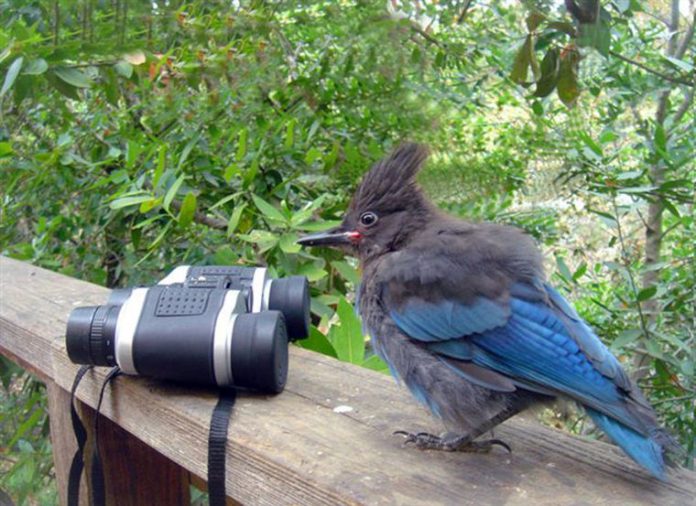The south Bay Area is abounding with an astounding variety of avian life. The fascinating hobby of bird-watching allows you to discover and appreciate the marvelous diversity of wildlife all around us. At water’s edge you may see a majestic great blue heron or a reclusive American bittern; you will learn how to tell the difference between great and snowy egrets; you might be surprised by a crested blue-and-white belted kingfisher suddenly diving into the water and emerging with a fish. Paddling on a creek or pond, you may see buffleheads (striking black and white ducks) or an elusive, gorgeous, multi-colored wood duck.
Take a walk among the trees and fields – listen closely for acorn woodpeckers tap-tapping acorns into an oak tree and Steller’s jays raucously mimicking other birds; watch northern flickers foraging on the ground for ants and tree swallows swooping in the air for insects. Be inspired by the thrilling sight of both large and small raptors soaring in our skies: Golden eagles, red-tailed hawks and falcons, including peregrines and kestrels. You will even discover that not all kites in the sky have strings attached – the white-tailed kite hovers in the air while scanning for a tasty rodent on the ground.
The hobby of bird-watching can be as uncomplicated as sitting comfortably in your backyard with a Peterson Field Guide in hand. You know what a robin looks like, of course, but do you wonder what that small yellow bird is that’s eating from your feeder? Is it a Western tanager, hooded oriole or American goldfinch? Is your tiny iridescent hummingbird an Anna’s or an Allen’s? Going on an organized bird-walk expedition gives you the chance to ask an expert for help in identifying common and uncommon avian visitors.
An excellent opportunity is offered through the Wildlife Education and Rehabilitation Center’s monthly bird-watching programs along Coyote Creek, just north of Morgan Hill. They are led by Dr. Jane Haley, a National Park Service docent for 29 years and a longtime WERC volunteer. Knowledgeable in the identification of birds by their flight, behavior, coloring, habitat and vocalization, Jane is more than happy to share her bird-scope and teach you how to differentiate between the high-in-the-sky turkey vultures, hawks and eagles, how to listen for warbling vireos and where to best glimpse a yellow-billed magpie or a goldeneye. Besides observing both year-round residents and migratory birds just passing through our area as the seasons change, program participants also learn to appreciate the ecological importance of wildlife and the various habitats.
The next bird walk will be held from 9 a.m. to noon Feb. 8. The programs are free, but space is limited and reservations are required. Due to uneven terrain, the walk is not suitable for young children. For directions and a list of birds you might see on your trip, visit werc-ca.org.
A plus: Going on a bird-watching excursion will help you keep your New Year’s resolution to exercise both your body and your mind. It’s a healthy and enchanting habit!
The Wildlife Education and Rehabilitation Center rehabilitates native wildlife. It is supported solely by donations from businesses and the public. To contact WERC, call (408) 779-9372 or visit www.werc-ca.org.










